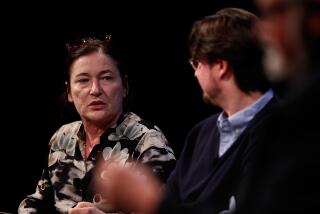Addressing the Challenge of Aging : Octogenarians Share a Lifelong Passion for Education
- Share via
CAMBRIDGE, Mass. — Religion 2040, “Perspectives on the Life Cycle,” has a lofty enough listing in Harvard University’s official course directory. More widely, however, the class Erik and Joan Erikson first taught here 25 years ago is known by a less-imposing title. “From Womb to Tomb,” it is called. Or, “From Bust to Dust.”
The irreverence in no way troubles the instructors. “Half charisma, half deference” is how Harvard University marshal and history professor Richard M. Hunt, Erik Erikson’s former head section leader, said students view the 84-year-old psychoanalyst. “Half Pied Piper, half gentle mentor.”
Strolling With Arms Locked
Indeed, students often tag along with the Eriksons or approach them on their daily walks through the now-frosty Harvard campus. Erik and Joan Erikson make a tight, tweedy pair as they stroll down Francis Avenue to their class in William James Hall, or head over to the Erikson Center on Cambridge Street: arms locked; she in sensible walking shoes, he in the Velcro-tabbed athletic shoes he wears even with his tuxedo; both with snowy hair and a firm, determined pace. They talk constantly, their conversation overflowing with private laughter. Kisses are common. Tenderness abounds. More than once, Erikson has been seen to spin his cane in the air, vaudeville-performer style, as the two octogenarians rolled back their heads in shared mirth.
“Prof. Erikson,” an earnest young undergraduate once panted on such an afternoon’s promenade, “I think I am having an identity crisis.”
And Erikson, as he recalled at a dinner in his honor here not long ago, “could not find any answer, except to say ‘Well, are you complaining, or are you bragging?’ ”
In class their humor is no less restrained, and is mixed generously with reminiscences and ripostes. The father of the term identity crisis stations himself in the foreground of a haphazard semicircle of students in metal desks.
Because his voice is thin, 83-year-old Joan Erikson sits close beside him, holding a microphone to amplify her husband’s words, and often adding a liberal sprinkling of her own.
Now they are ushering their students through the cycles of life, starting with childhood and society (the subject of Erik Erikson’s most acclaimed book), venturing into identity and youth, pausing to examine the questions of women, men and adulthood. By term’s end they are focusing on the latest passion of the Eriksons: old age.
So here they are, they will say in the same easy tone they might use to order tuna sandwiches. Here they are in the eighth cycle, the concluding stage of Erik Erikson’s “epigenetic” stages of life.
“It’s not a plateau,” Joan Erikson said one afternoon. “Old age is not a plateau where you walk to the end of it and fall off the other end, the way I thought it would be when I was a kid. Suddenly you’re old.”
Between them a quick smile passed, a laser ray that made words irrelevant.
‘It’s an Adventure’
“Well,” Joan said of this aging experience, “it’s an adventure.” She laughed. “It’s fun.”
“How you get there is a strange question,” her husband said. He speaks slowly, still revealing the traces of childhood in Germany, young adulthood in Austria. “You suddenly find you are there. How can you set out to get there?”
“I don’t think young people expect to get old,” Joan said. “In some magic way, they think they are going to stay the way they are forever. Maybe get smarter, richer.”
Said Erik: “But one has good memories, as an old person.”
It is hardly surprising that the Eriksons should choose to turn their attention to the topic of aging at this stage in their lives. Harvard colleague B. F. Skinner, 82, also has targeted the topic in recent years. In advanced years, artists Henri Matisse, Pablo Picasso and Marc Chagall grew furious in their productivity. In less than six months, Joan and Eric Erikson, for their part, will have published three books between them.
“There’s a real demarcation between those old people with whom one only speaks of the past, and those old people one draws into daily life. Erik and Joan are in that second category,” said Dorothy Austin, the Harvard psychoanalyst who directs the university’s Erik H. and Joan M. Erikson Center.
“They’re also the sort of people to whom you can confide the sort of things one usually spares old people,” said Austin. “In that sense, they’re real contemporaries, wise ones.”
So contemporary, in fact, that it was Joan Erikson who started the dancing at Austin’s birthday party not long ago. “Come on,” she told her husband impatiently, “let’s get this crowd moving.” At midnight, a well-meaning friend pointed to the hour and gingerly suggested that perhaps the Eriksons would like to be taken home.
“What?” a mock-indignant Erik said, “and give up dancing with my beautiful wife?”
This fall, the Eriksons joined with California writer Helen Q. Kivnick to address the challenge of growing old in “Vital Involvement in Old Age: The Experience of Old Age in Our Time” (W. W. Norton, $19.95). “We are all facing the prospect of a steadily increasing longevity in an unpredictable technological future,” they write in their introduction. And yet, “the fabric of society, the center, ‘does not hold’ the aged.”
Studying ‘Ordinary’ People
Their book-length discussion centers on the subjects of America’s longest ongoing study of so-called “ordinary” members of society, the participants of the well-known “Berkeley survey.” Now nearly 60 years old, the study has followed the lives of a group of children born in 1927 and has by necessity encompassed the parents of those now-adult children. It is these 80- and 90-year-olds who provided the case histories for the Erikson/Kivnick book: normal adults who have thrashed, glided, stumbled, sleepwalked through the process of old age.
“Well,” Erik said, only slightly suppressing his wry smile, “normal for Berkeley.”
The population afforded the Eriksons a living laboratory for Erik Erikson’s interdisciplinary theory of the stages of human life. Key among his tenets is the factor many consider to be the secret of his theory’s durability: the fact that he looks at the entire life cycle in the context of the historical moment, in the setting of the specific social milieu. Working as much with anthropologists such as Margaret Mead as with other established leaders in the field of psychology, Erikson, as Dorothy Austin likes to put it, “took psychoanalysis off the couch and into the field.”
For Erikson himself, the lifelong analytical journey began in the early 1920s, when the slender young man, intent then on becoming an art teacher, traveled to Vienna to study his craft. Born in Frankfurt-am-Main in 1902, Erik Homburger Erikson was raised by his mother and stepfather, a German-Jewish pediatrician. His father, a Dane, had abandoned Erikson’s mother before the boy was born. Tall, blond and blue-eyed, Erikson would grow up being called “the goy “ by Jewish boys, and “the Jew” by Gentile classmates. Perhaps because his own adolescence was so troubled--”on the border between neurosis and psychosis” is how he has described that time in his life--Erikson has always felt a strong bond with people on the bridge between childhood and adulthood.
A mecca for artists and intellectuals, Vienna was bursting with activity in those edgy days between the wars. Studying at the Vienna Psychoanalytic Institute, Erikson became a protege of the aging father of the field, Sigmund Freud. He was trained and analyzed by Freud’s daughter Anna, becoming, in the process, “part of that whole Freudian circle.”
“Incidentally,” Erikson said of that period, “speaking of old age, old Freud was a very sick old man, and also a very calm and wise old man. Certainly, what would you expect? Those were the last years when you could meet him, and the greatness of that man--and the moods of that time, all the theory that was coming into being.”
A Masquerade Ball
Often, the mood was festive. At a masqued ball at the summer castle of the Empress Maria Theresa, Erikson was dressed as a young Turk, resplendent in a crimson fez, when a dazzling Gypsy dancer from Canada waltzed into his arms. “Have you got music?” the former Joan Mowat asked playfully 56 years ago, as if ready to dance to the memory even now. They were married soon afterward.
By all accounts it was the collision of two creative galaxies. But a reminder of this portrayal of their first encounter turns Erik and Joan Erikson once again into a kind of psychoanalytical Burns and Allen.
Erik (stage whispering): “Joan, what’s a galaxy?”
Joan (hissing in much the same tones): “Oh, you know, Erik, a whole lot of stars.”
Quickly, Erik turns serious. “I hope it just doesn’t come off like all people at that time were waltzing about. Sure, well, that was true. But we were also in Vienna, and we were also working, working hard, and doing psychoanalysis, causing it to happen, to become.”
In 1933, Erik was graduated from the psychoanalytic institute, and “Joan, as I say, brought me here, to the United States.” The Eriksons landed at Harvard, where psychology professor Edward Boring greeted the young analyst with such enthusiasm that he awarded Erik an honorary bachelor of arts degree. “Otherwise,” Erik has said, “I would have had no degree at all.”
Even before he left Vienna, Erik’s drift away from the rigid doctrines of Freudianism was beginning. Freud viewed each person as essentially prefabricated and inserted into a group. But Erik saw the process of individual development as at once physical, psychological and communal. Still, opening a practice on Marlborough Street as Boston’s first child psychoanalyst, he continued to incorporate certain principles of Freudianism in his own points of view. Some appeared in the book “Childhood and Society,” a fact that might have plagued him in subsequent years were he less flexible in his thinking.
Fury in Her Voice
“Prof. Erikson, you have compromised the cause of women!” a young woman accused during a class at Harvard in the 1960s. With fury in her voice, she proceeded to read a passage from the book dealing with penis envy. There was a pause while Erikson pondered what he had heard.
“Did I really write this?” he asked.
“Yes,” the student said, lambasting him for his obvious anti-feminism. “You did.”
“Well then,” Erikson said. “I was wrong.”
Erikson left Harvard in 1936 to do research at Yale’s Institute of Human Relations, and three years later packed up his wife and young daughter and headed off to a professorship at UC Berkeley. But his tenure there ended abruptly when, a decade later, Erikson resigned in the wake of the university’s loyalty oath controversy. He emphasized in his letter to the Board of Regents that he had never been a communist. “One may say, then,” he wrote, “why not acquiesce in an empty gesture (signing the oath), if it saves the faces of very important personages, helps to allay public hysteria and hurts nobody? My answer is that of a psychologist: I do believe that this gesture, which now saves face for some important people, will, in the long run hurt people who are much more important--the students.”
Students now tend to venerate the professor who spends half the year in balmy Tiburon, Calif., and half in leafy Cambridge. But even when colleagues like Richard Hunt refer to him as “a monument,” Erikson resists the kind of deification that sometimes comes with the academic turf. “If they sit at my feet, I tell them to get up,” he said, a trifle irritated. “What kind of business is that?”
A Special Partnership
What they admire, also, these students who flock to the Eriksons’ Life Cycles class, is the special partnership before them. “Undergraduates love them,” Dorothy Austin said. “Where else can you see two 80-year-olds who have been intellectuals in the classroom walking hand-in-hand through Harvard Yard?”
From Erik Erikson there is no contesting the contention that the match was love at first sight. “Of course, of course,” he said, “that’s what it has to be.” But it is Joan Erikson who offers the secret of their marital success.
“First of all you’re incompatible,” she said. “So then you never have a dull moment.”
They are opposites, she insists: “very opposite. But to be opposite, you don’t have to be antagonistic. I think you can appreciate somebody else’s characteristics and ways of doing things without necessarily being them, or trying to be them--and without trying to change them, hopefully.”
She is an artist, a firm believer in the therapeutic properties of the arts, and once created a tapestry depicting her husband’s theory of the cycles of life. He, too, began life as an artist, and still sees the planet through the eyes of the painter. “Hush, all of you, look at the trees,” he once admonished a carful of conversing colleagues on an autumn drive through New Hampshire.
So how are they so different? Joan Erikson’s big laugh comes gushing forth. “Oh, look, that’s none of your business.”
Though their professional interests of late have emphasized the elderly, the Eriksons continue to observe the intergenerational nature of life. Parents of three grown children, they have noticed that recently, as Joan put it, “Fathers are taking more of a role. People have become enlightened by what has been taught about child development. Fathers are much more involved, and are enjoying it, that’s the nice part.” She smiled, remembering a male student who had brought a knapsacked baby to class the day before. “They look so pleased with themselves.”
“And I would even say the babies look pleased,” her husband added.
‘Husbands Aren’t Wives’
But some shake-ups in the family structure have had less pleasant outcomes, the Eriksons maintain. “Husbands aren’t wives,” Joan said. “It is very hard for them to be the hub of the wheel. They will do these various things, and expect tremendous approval for it. Some of them are great cooks, but it takes a half an hour when the woman does it, and an hour and a half or two hours when they do it.”
“Wisdom and the Senses” is the title of Joan Erikson’s next book, due out this spring from W. W. Norton. The subject is what she calls “our natural resources,” the senses, “and how little we value them.”
But in turn this matter folds into their work on aging, since Joan fumes fairly fierce on the notion of “keeping your senses much more acute by paying attention to them.” But then, she argues, aging itself is something few people prepare for.
“I hope they get after prevention, and stop fussing around trying to take care of symptoms,” she said of the flock of gerontologists suddenly filling universities. “I think taking care of symptoms is great, but if you put all that money into that, you don’t have anybody doing research on how to prevent it. Cataracts. Arthritis. You name it. There’s so much more money spent on taking care of these things than there is on preventing them.
“We should start way back taking care of these kids and these young adults so they aren’t dilapidated by the time they get to old age,” she said. “Their senses have been abused. We don’t push it that our lights are glaring and bad in the schools; that noise is horrible, you can ruin your eardrums and so on. Noses, mouths, the works, they’re all overlooked.”
One large bane of Erik Erikson’s own old age is the decline of one precious sense: his hearing. He now wears double hearing aids and “hates being hard of hearing,” close friend Austin said. “He says people automatically assume you are senile as well.”
With “Childhood and Society” now in its 35th edition, and Erikson’s 12th book, “A Way of Looking at Things,” due out from Norton next month, that prospect seems highly unlikely. A dimming of Erikson’s legendary wit would appear just as improbable.
Not long ago, in the crush of Harvard’s 350th birthday celebration, Erikson and university news officer Deane W. Lord found themselves being propelled by a crowd that seemed to have taken a life, and a direction, of its own. “Deane, do you know where we are going?” Erikson asked pleasantly. “Oh, I don’t know, Erik, I thought we’d go to heaven,” Lord replied. “Oh,” Erikson responded in the same cheerful spirit, “and would you have the address?”


